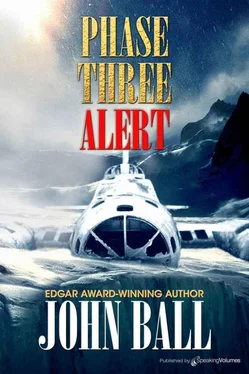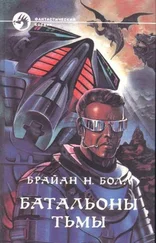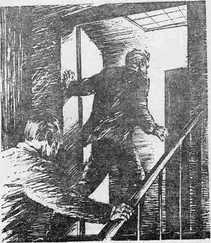Although he didn’t say so, the colonel was perfectly aware that the B-17 had been designed with the knowledge that most of the pilots destined to fly it would be green and inexperienced. It had been made as simple as possible as a result. Few of the aircraft commanders who were assigned to them had a total of 600 hours when they first took over in the left-hand seat. “Go ahead and draw,” he said.
Sergeant Feinberg did the honors. He produced the cardboard box that held the names and shook it vigorously. “Gentlemen,” he declared, “it is now time for me to reveal that I happen to hold an FAA commercial pilot’s license and I have well in excess of a thousand hours. So my name is in here a good many times.” He beamed at the colonel. “Sir,” he asked, “will you do the honors?”
“I would prefer to be kept out of it,” the colonel said.
Sergeant Feinberg caught sight of Bill Stovers, who was just coming out of the fuselage after having checked everything there. “Pull a name, Bill,” he invited.
Sergeant Stovers reached in an extracted a piece of paper. Since no one seemed anxious to take it from him, he opened it and read aloud. “Colonel James Kleckner,” he announced.
While waiting for weather clearance, Major Eastcott laid out the search patterns to be followed the moment that conditions permitted takeoffs. Sondrestrom, at least for some time, would not be able to help; the field there was firmly closed down and the weather section at the scene held out no hope of improved conditions for at least twelve hours. With luck, the Thule rescue craft would be airborne long before that.
Of the four aircraft available, three could actually land on the ice cap: both of the helicopters and the ski-equipped C-130. The major was not at all sure that the B-17 would be permitted to fly, but he entertained no doubt that it could. In laying out the search patterns, he plotted the relatively short-ranged Sikorskys to cover the nearby areas. They were high probability sectors on his layout and if either helicopter made the find, it could set down and pick up the survivors immediately. He had plotted rescue efforts many times before, so the word “survivors” came automatically into his mind. But he did not for a moment forget the vital Bennett respirator.
The C-130 he scheduled to fly at a higher altitude, searching for a possible flare and keeping a constant listening watch in the hope of picking up even a very faint radio signal.
The B-17 — which had long-range capability and could maintain a safe slow speed-he assigned to an advancing line search back and forth across the ice cap at low altitude. That would be almost entirely a visual operation. He was glad that he had the old bomber to put to work; it was vitally needed. He knew without checking that there was nothing up at Alert that could come down to help out.
When he had his charts completed, the major called for a conference of the aircraft commanders. In response majors Kimsey and Mulder came up from Det. 4, Captain Boyd checked in for the C-130 crew, and Scott Ferguson came with Colonel Kleckner. In ten minutes Major Eastcott laid the whole picture out and made certain that each crew commander understood his individual responsibilities. Although the tensions inherent in combat situations are great, a coordinated rescue effort can reach even higher levels of emotion, and the air was charged with it. When Eastcott finished, he asked for a final status check. As he had expected, every man and every aircraft was ready and waiting; only the weather was holding things back.
A six-pack arrived from the mess hall with hot food for everyone. That was a welcome interruption, particularly since none of the aircraft commanders or crewmen had even contemplated leaving their duty stations to eat. The word also came that a supply of box lunches was being prepared and would be delivered to the flight line shortly.
By the time that the meal was over, it seemed to Colonel Kleckner that the weather had definitely abated a little. Everyone else was constantly checking too, anxiously awaiting wind conditions that would be down enough to permit safe takeoffs. Det. 4 once more wanted to go immediately and once more the colonel refused permission. He had one urgent rescue situation on his hands and he most emphatically didn’t want any more.
At 1350 Weather called to say that operations might be possible in another one to two hours. That was regarded as definite and the tension in the terminal increased even more. Major Eastcott called the hospital and assured Captain Bowditch, who answered, that the air search would be launched shortly, and at the earliest possible moment.
Twenty minutes later, after his fifth trip outside since the weather announcement, Major Ramsey declared that the winds were off enough to permit helicopter takeoffs. Colonel Kleckner went outside with him to verify that, came back in, and said without dramatics, “I think we can get ready now.”
The Thule flight line erupted into action. The Det. 4 hangar was the first one open; within two minutes after that the howl of turbines began to override the constant noise of the wind. From a little farther up the field, the blast of the APU on the C-130 Hercules added a fresh voice. And the main door to Hangar 8 was activated to permit The Passionate Penguin to be pushed out onto the ramp.
As the four mighty turbine engines of the C-130 began to add their full-throated roar to the cacophony of sound, for just a moment or two Scott Ferguson wished that he had power like that at his command. He was used to it and he knew what it could do. Then he purged that sinful thought out of his mind the way that a Puritan would have condemned adultery, and remembered that almost 5,000 horsepower was all that he could possibly want or need.
Andy Holcomb was busy making a totally unnecessary final exterior inspection of the B-17; it was in perfect condition and he knew it. As he had many times before, particularly for the taxi tests he had made, Ferguson climbed up the crew ladder into the Boeing bomber, planted himself firmly in the left-hand seat, and secured the newly installed harness. It was familiar to him now, the whole flight bridge and cockpit: every control, every gauge, and every instrument. He moved the yoke backwards and forwards; then he turned the wheel and felt the balance of the movable surfaces.
Sergeant Stovers tapped him on the shoulder. “All set in the back,” he said. It was odd seeing his familiar face in a strange setting; then he forced himself to remember that Stovers, his loadmaster on the C-130, was just as fully qualified on this older, smaller, slower, but dependable piston-powered aircraft. Jenkins came up the ladder with a grin on his face. “Dammit, she’s beautiful!” he said.
A full sense of shame punished Ferguson for his heresy; he had asked for this, he had pleaded for it, and he had relinquished the C-130 to get it. He did not understand himself; he had wanted to fly this aircraft so badly. Then it came to him: the rescue was the thing — the all-important mission of saving human life. He had known too well that the Hercules was far better equipped, and that hammering thought had been plaguing the back of his mind. He wanted to make his utmost effort for the sake of the people somewhere out on the ice cap and for the helpless child he had last seen lying rigid in a coma in the hospital with an inadequate temporary respirator keeping her alive minute by minute. Out there somewhere there was a machine that might possibly be able to give her back her life.
God damn it, be bad an airplane to fly, get on with it! Boyd and his crew would milk the C-130 for everything she could give and they knew their business. He felt the airframe move and moments later Colonel Kleckner came into the cockpit. “The winds are definitely down,” he said quite cheerfully. “They’ve fallen off noticeably during the last fifteen minutes. How does she look?”
Читать дальше












